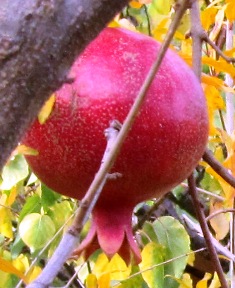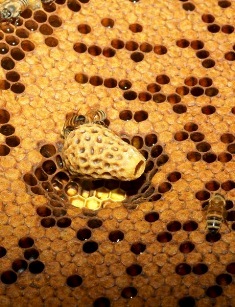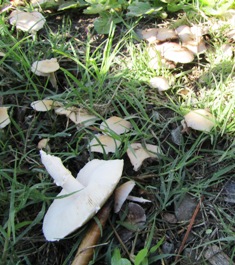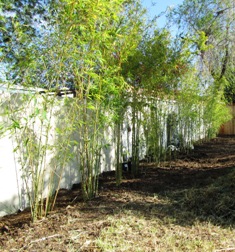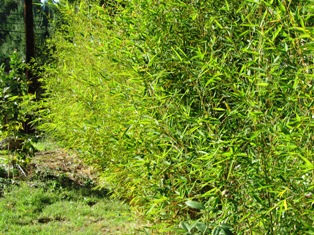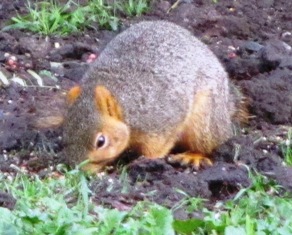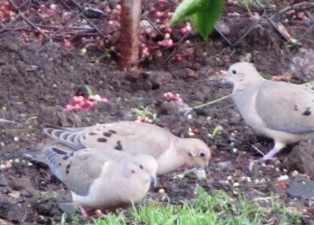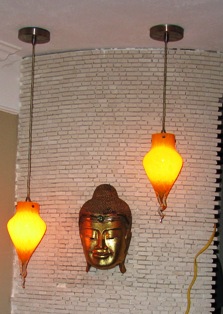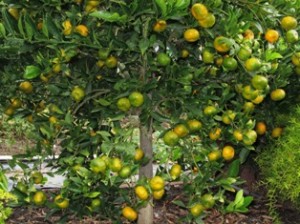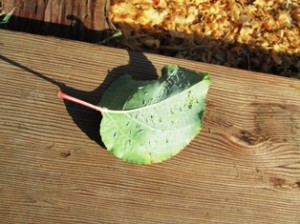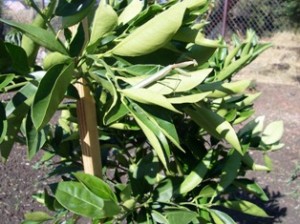Archive for the 'Gardening' Category
Pomegranate: A Jewel of a Fruit with a Long History
This time of year, you’ll find plenty of pomegranates in the markets and on harvest festival tables. It’s an important fruit in Middle Eastern cuisine. In the fall, pomegranate plants produce garnet-colored fruit with a leathery rind.
The fruit ranges in size from that of a large apple to a small kumquat (for ornamental types of pomegranates). The pomegranate’s treasure, however, is hidden inside. There you’ll find bright red juice and glistening seeds that taste sweet or bittersweet and astringent.
The pomegranate was known to the ancient world. Long before the birth of Christianity, the Egyptians viewed the fruit as a symbol of prosperity. The Bible contains numerous references to the pomegranate and its symbolism as an image of fertility.
The fruit is indigenous to Persia (the area that includes the modern countries of Iran and Iraq). The pomegranate’s popularity has spread since ancient times throughout the Middle East, India, Asia, and elsewhere around the world.
Pomegranate has important uses in the ancient Indian Ayurevedic system of medicine, including as a counterbalance of diets high in sugar and fat. In Northern California’s east bay valleys, the plant is easily cultivated. Our neighbors to the left, right, and rear of our farmette all grow pomegranates.
There are many cultivars of the plant (bushes, trees, and ornamental varieties). Our trees are young and still pretty small. The branches are stiff and tend to arch. Small oval leaves create a delicate open pattern–almost a lacy look–in the garden.
The best method of propagation is through cuttings from wood that is at least a year old. The plants are excellent landscape choices. They are not too picky about soil and as they get older are somewhat drought tolerant. Grow in full sun and irrigate young plants. You[ll be rewarded with trees that remain relatively pest-free and bear plentiful fruit.
Ripe fruit still hanging on the tree can split open, revealing the seeds. But many who grow this fruit and appreciate its nutrient, antioxidant, and medicinal value seldom leave these gems on the tree to over-ripen and fall.
Slow Moving Storms Saturate the Farmette
The meteorologists on Bay Area television warned for a week that a series of slow-moving storms would hit the region in a one, two, three punch. One weather forecaster explained that the cloud cover of the storms stretched from San Francisco to Hawaii. On our Henny Penny Farmette, the storms dropped a lot of water but the septic handled the deluge well.
Over the summer months, we had relocated mounds of earth to strategic areas so the water of these types of winter storms would flow away from the house. A walk around the farmette today convinced me that we did the right thing. Mostly, the water stayed away from the house foundation. Also, the French drain that encircles the perimeter of the house seems to be working well.
Still, the storms that dropped nearly eight inches of rain in the north bay, triggering emergency flash flood warnings for local streams and rivers, also saturated our farmette. Water pooled on some of our gravel paths. The largest reservoir of standing water is in front of the house. That area has been excavated for construction of our wrap-around porch and steps.
After enduring a hot, dry summer, the plants that are wintering over seem to come alive in the rain. In particular, the irises in beds around the farmette are starting to bloom. The French perfume lavender is also sending forth purple flower spikes. Whether it is summer heat cracking the ground or winter rains that saturate and flood it, each season has challenges but also offers gifts. To live in harmony with Mother Nature is be accepting and ever-mindful of the way nature achieves balance.
A Kitchen Created from Gifted and Discarded Materials
Built in 1947, the Henny Penny Farmette cottage didn’t look like a dream home when we first saw it. However, we knew we could make it not only habitable but functional and pretty. There had been a family living there before we purchased the property. They left behind some kitchen cabinets but that was about all.
At one point the house had some pretty hardwood flooring. I know this because I met a neighbor who bought it from the family who lived here. Apparently, most of the interior that wasn’t nailed down was sold or otherwise removed. When we got here, there was no bathroom sink or appliances (unless you count an old refrigerator standing abandoned on the land).
Bathroom and kitchen became construction priorities for us. From a retail marble outlet, we secured permission from the owner to take what we wanted from the store’s dumpster. We found enough discarded marble to create a guest bathroom floor in one color and a master bathroom floor (in two colors). It meant my husband Carlos would have to painstakingly cut the tile, but he was up to it.
We found marble countertops discounted by a supplier in Oakland. We also discovered that the supplier had some pieces in a discard pile (for a fraction of the cost but he would only sell it on Sundays) requiring us to make another trip. We like the “L” shaped counter, but had to cut the holes for the sink and cooktop. Carlos created a beautiful sunburst as the focal area on the wall behind the cooktop.
We discovered a closeout sale on Italian honed marble but had to drive for two hours to Sacramento to get it. The price was great but the speckled marble was rather plain. I asked Carlos to cut some rectangles in the same color as the sunburst and we played around with different patterns finally settling on a simple one.
It has taken almost three years for Carlos and I to finally finish the kitchen (although we haven’t been working on it full-time, there are other tasks around the farmette that must be done, too). We are pleased with the result.
Our refrigerator and dishwasher do not match the other appliances that we have in the kitchen, but they were gifts that we will use until we need to replace them. We got the remainder of the appliances (all stainless steel) at a fire sale price for the lot from a friend going through divorce. But the kitchen is quite functional. Best of all, we did it for a fraction of the cost of a kitchen remodel at today’s prices and in the process kept materials out of landfill.
The Inherent Gifts of Observation
I saw some wild turkeys today strolling through the acre behind the farmette. If I hadn’t noticed them, I wouldn’t have captured them on film. They disappeared as quickly as they showed up. You have to pay attention for the moment is soon lost.
Some people never lose that childlike wonder of noticing everything in their environment. My grandfather was like that–a veritable treasure trove of information based on the observations of his world. An attitude of gratitude seems to come easily to such individuals, as if noticing and feeling thankful are linked.
The Buddhist practice of mindfulness suggests that kind of noticing. For example, if you spot a flower while out walking (perhaps it even grows through a crack in the sidewalk), you might bend down to examine the flower. Does it offer a fragrance, beauty in its perfect symmetry, a ladybug on it’s stem, delicate leaf, or a gentle sway in the breeze as if it is dancing? These are the gifts the flower offers, the gifts it holds for you when you take the time to notice.
I like working with the bees and seeing up close their world within the hive. I had never seen a “queen house.” When I did for the first time I felt astonishment at how perfectly functional it was. Honeybees create comb to seal in the honey–their food (and ours)–and these honeycombs and queen houses are functional, perfectly formed, and beautiful to gaze upon.
For my grandfather (and also in my own experience) observing nature’s glory conjures feelings of appreciation for so many blessings–the ability to see, hear, feel, touch, think, and sense what is present, what co-exists around us. This renders the perspective that we humans are mere specks in cosmic creation.
Our lives are richer when we appreciate what we have and take time to notice how richly adorned our lives are.
Is It a Mushroom, Morel, Truffle, or Toadstool?
I wouldn’t call myself a gastronome when it comes to mushrooms–my taste and enjoyment of them is not that discriminating. I like them in food, but I am not fond of finding them popping up all over the farmette after a rain. My displeasure at seeing them in the lawn, around the raised planter boxes, on the pathways, or in the orchard and garden stems from my not readily knowing which types are beneficial s and which are harmful. There are literally hundreds of different species, some are poisonous.
The mushroom (often called a toadstool) is the visible sign of the presence of a fungus in the soil. The toadstool generally has three parts–a stalk or stem, a cap, and gills. You might think of the hookah-smoking caterpillar perched on top of one in Alice’s Adventures in Wonderland, by English author Lewis Carroll.
Mushroom color varies with the species of fungus that produces the fruiting body. While many have neutral coloring, some, like the poisonous fly agaric (Amanita muscaria) that you would find in the woods associated with conifer and birch trees, has a brilliant red cap with white scales.
Don’t eat mushrooms or toadstools you find growing in the wild unless you are an expert on fungi.
The majority of fungi won’t harm the garden (although some do). If I don’t recognize the type of fungi that is growing, I either ignore them or use a spade to dig them out. I dispose of them in the garbage. Some toadstools are actually beneficial to the soil, adding back in certain nutrients. Such fungi have a symbiotic relationship with garden plants. However, others can have spores harmful to humans.
I’ve used a lot of soil amendment and compost on the property. There may be pieces of rotting wood buried under the dirt. Fungi need a food source to grow. In packed soil and the damp conditions following a rain, toadstools pop up, seemingly everywhere.
Alas, I cannot as yet tell the toadstool from the truffle or morel, so highly desired in the French and English culinary traditions, so I won’t eat any of them. And as for sitting on one, well . . . I leave that for the hairy worm of Lewis Carroll’s imagination.
Bamboo Transforms Stark into Lush in No Time
New to the neighborhood and homesteading, we were offered a patch of clumping bamboo that was growing on the land behind us when we first moved to the Henny Penny Farmette. We worried as many do about the spreading habit of bamboo. The last thing we wanted were neighbors complaining that it had sprouted onto their property.
Back then rotting fences lined the boundaries of our land. The house, too, was in decrepit condition, but Carlos and I saw the potential of the property. We also liked the idea of natural fences or at least plants to soften the stark look of all those boards. Bamboo, we reasoned, made good sense: it was drought tolerant, easy to care for, and quick growing. It could turn a stark, ugly fence into a lush privacy screen in no time.
The vibrant green color turns to a golden amber in the fall and the plant (related to grass) moves gracefully in the wind. The plants were mainly clumping types of bamboo so they were not as likely to spread like thistle in the wind. When we were at the local DIY store, we checked the price of bamboo in pots and quickly realized that the gift we were to receive was worth several thousand dollars.
With shovels in hand, Carlos and a worker began digging along one long fence line on our property. After the planting holes were prepared, he and the worker used the wheel barrow to transfer the bamboo from the back property to ours. The two men planted and deeply watered the bamboo.
Winter rains in 2011 helped the bamboo take hold. It grew well the first year with a little extra watering over the summer. The next rainy season again fostered new growth. Now we have a verdant green fence line of thriving bamboo.
Serve Up Seeds for Furry and Feathered Creatures
Squirrels can contort their bodies into bizarre and exotic positions just to get at the seeds in a bird feeder, as any wildlife watcher can tell you. But they aren’t crazy about all birdseed. Safflower is a good example of a seed loved by birds but not squirrels. The squirrels will forgo a whole feeder of that seed in order to dine on sunflower hearts that is also a favorite of chickadees, finches, and woodpeckers. Pesky squirrels will also paw through a bird feeder to eat other seeds mixed into a commercial wild bird feed but still pass on eating the safflower if it is present.
Since both squirrels and many species of wild birds love sunflower seeds, we grow several types throughout the summer. When fall approaches, we place the dried heads of the sunflowers in an area away from a bird feeder to attract the squirrels and hopefully limit their foraging of food intended for the feathered wildlife. Sometimes it works. However, mourning doves are ground feeders and so are quail. We’ve found the squirrels and the birds foraging together for sunflower seeds.
A squirrel and mourning dove share a meal
The finches enjoy the black Nyger (or thistle) seeds so we keep one feeder of that seed just for them. We love the splashes of yellow (the coloring of their breasts) as they flit around and perch on the feeder to devour their favorite meal. But other birds with small bills like the California quail, pine siskins, towhees, dark-eyed juncos, song sparrows, and purple finches also are attracted by Nyger seeds and will dine often if the feeders are kept filled.
Squirrels and some types of birds particularly enjoy pumpkin seeds and peanuts, so we also put those out when the weather becomes bleak and we’re pretty certain that the wildlife around us isn’t finding much food. During those periods, we also hang suet for the birds, especially those that hang around for the winter but don’t have a lot of food choices such as crows, robins, and the American goldfinches.
When you ensure adequate food supply for the furry and feathered creatures in your backyard, you will be rewarded with many entertaining and heart-warming images. Keep your camera handy for capturing squirrel contortions or surprising pictures of who dines with whom.
Let There Be Light–In the Kitchen, At Least
A new project seems to beckon at every turn here on the Henny Penny Farmette. But as we anticipated having our first celebratory meal at Thanksgiving in our farmette kitchen, we decided to make working on the interior of the house a priority. Well, not the whole house. Technically, I mean the kitchen/dining room/living room space. Although it’s the size of a postage stamp, the space affords easy flow.
At roughly 600 square feet, the farmette kitchen/dining room/living room space at times has felt tight, cluttered, and dark. But after we moved out some boxes (yes, still unpacked from two years ago) into a storage shed and thoroughly cleaned the area, the room seemed more expansive. A few days before Thanksgiving, Carlos and I addressed the lighting problems.
We needed light over the long granite counter that separated the kitchen from the dining area. We also had a very dark area at the end of the counter, space that sort of recessed back into an area that we use as extra kitchen storage and wet bar.
Our so-called “art” wall, tiled in stone (the wall is shaped in a half circle), that could use soft illumination. Finally, the living room had no lighting (although at one point, a single naked bulb hung from the ceiling). If we actually wanted to see our guests, that area needed attention.
We picked three areas (foregoing the living room for now, although we do have a plan for it). Four yellow glass pendant lights went in over the counter. Two yellow blown glass pendants were hung near the art wall. A crystal chandelier that hearkened back to the elegant ballrooms of the 20s and 30s was hung above the dining table. With the lighting finished and much to be thankful for, we sat down and enjoyed our Thanksgiving dinner. That was when I noticed the floor…still no flooring. Argh! Like I said, a new project at every turn.
Pest Control
A rain storm threatens to blow in over the Northern California coastline but here in the shadow of Mount Diablo, the wind is warm, the sky is blue, and the birds and bullfrogs are singing. I have to grout the kitchen counter backsplash and otherwise prepare the farmette for Thanksgiving, a goal I set at the beginning of the year. But this morning, I feel inspired to stroll through the garden to inspect my still-blooming roses, pluck and devour a strawberry or a ripe fig, or sample the mandarin oranges from the heavily laden tree. What could possibly ruin the start of such a beautiful day?
Pests, that’s what! I found colonies of aphids on the underside of the leaves still hanging onto the young apricot trees. Scrutinizing the underside of the leaves on the orange tree, I found ants inching up the trunk. That suggests to me there is a food source in the tree for those ants. So now I have deal with pests before starting the kitchen grout work.
Pests and gardens go together. I might not be able to eliminate the pests, but at least I can control them. I like an integrated control approach to dealing with pests. For example, I try not to plant all of one type of plant or tree in one area–that’s just inviting trouble in the form of pests that attack that type of plant. Also, I’ve included different varieties of the same type of plant like an apricot and a apricot/plum hybrid called an aprium tree. When I see leaves on my roses or trees with aphids, I pick the leaves off and put them in a bag (not the compost pile) to dispose of them.
My heart feels lighter when I spot a praying mantis in the garden for these amazing little creatures love to eat moths, flies, grasshoppers, crickets, and other annoying little pests. In fact, I like to introduce populations of helpful insects to compete with pest population. Green lacewings or “aphid lions” devour aphids, lots of them, but they’ll also dine on spider mites and mealybugs. Ladybugs (more correctly, “Ladybird Beetles”) are also a favorite of mine since they eat aphids, mites, and scale insects.
Spiders trap mites and pesky insects in their webs and I feel fortunate to have many in my garden. Occasionally I see those shiny black beetles known as Ground Beetles but don’t handle them because they stink. However, they can serve as a veritable hungry army against cutworms and the larvae of other pests in the garden.
I don’t like poisons or insecticides, but I will mix soap with water to spray some plants. Companion planting, or the growing of plants in close proximity for both plants’ mutual benefit, such as enhancing soil nutrients and discouraging harmful pests, is another way I control pests. So while I would love to enjoy my early morning, I think I’d better get to work on the pest problem now. The grouting can wait. There are still two days before Thanksgiving.
Inviting Nature in through a Kitchen Garden Window
At only 1,000 square feet, our farmhouse, at times, felt claustrophobic to me after we moved here in 2010. I needed windows and lots of light. I wanted hardwood floors and granite countertops. But I also wanted to reuse, recycle, and do the work as inexpensively as possible. My husband Carlos is an architect and I’m his number one (dare I say visionary) helper. Together we’ve done remodels on both coasts, so a little farmhouse should be no problem, right? We had no idea how much work was (and still is) ahead of us.
Fans of network television home improvement shows will tell you that if you ever want to make your money back on a renovation, fix the kitchen and the bathrooms. So, of course, those were high on our list of priorities. Rotting wood and mountains of broken ceramic tile had to be carted away before we could even start our interior work. But we did put in a marble kitchen floor. Carlos laid it out in a pretty pattern. It looks lovely, is easy to keep clean, and feels cool under bare feet in the summer.
Finally, we began to slowly and methodically open up the space. Inside the kitchen, we installed the back splash of Italian honed marble that we bought at a closeout sale. We reused the garden window. For me, windows are a lovely way to link indoor with outdoor space. Framing the window and adding a flourish of crown molding finished it off nicely. Now I can look out on a maple tree, roses, and lavender planted along the fence line when I do dishes. Anchored in front of that window, I incubate my ideas for my books and dream of what renovation project to tackle next.
 Facebook
Facebook Goodreads
Goodreads LinkedIn
LinkedIn Meera Lester
Meera Lester Twitter
Twitter




